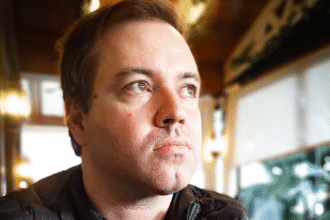The scars of the Second World War echo in post-war Romania, where tyranny and oppression became everyday life for Romanians. In the launch of the historical novel “The End of the Whispers”, by Alta Novel, the renowned author Ruta Sepetys dives into deep research to reveal a little explored side of Romanian history, marked by silence, pain and unbreakable persistence of the human spirit. Starring Cristian Florescu, a 17-year-old boy who dreams of becoming a writer, the plot unfolds against a backdrop of dictatorship and hunger, where choices become terribly difficult and hope is found in the darkest days.
In the context of Nicolae Ceaușescu’s dictatorship, Cristian Florescu finds himself in a cruel dilemma, blackmailed by the secret police into becoming an informant. Amidst isolation and fear, he must choose between betraying everything he holds dear or using his position to undermine the ruthless tyrant who rules Eastern Europe. Ruta Sepetys, known for her moving stories, shares real moments from Romanian history and immerses the reader in a captivating plot, where hope is a light that shines even in the darkest hours.
The author, published in more than 70 countries, masterfully mixes fiction and reality in “The End of Whispers”, portraying a period of bloody revolution that left a questionable legacy in the government of Romania. In a moving narrative, Ruta Sepetys describes the resilience of a subjugated people and the search for change in the midst of an era marked by painful silences.
What was your research process and how did you find information about post-war Romania?
My editor in Romania helped coordinate me on several research trips so I could peel back layers of history and try to understand what it was like for ordinary people to live amidst an empire of fear. I used Bucharest as a base and then took several trips to other parts of the country, including the beautiful region of Transylvania. I owe an enormous debt of gratitude to the true witnesses who so generously worked with me and shared their experiences. the interviews with Romanians were shocking, inspiring and unforgettable. For example, I interviewed the soldier who was ordered to execute Ceausescu. Listening to him recount the quest was a book in itself. Interviewing many Romanian citizens not only informed my research, but also helped me piece together the novel’s characters.
How did you balance the mix of historical fact and fictional plot in “I Must Betray You”?
The work towards balance starts very early on during my research. My research process tends to be very immersive. I travel to the locations where history took place. I collect period artifacts and comb through news archives, photo archives, and historical archives for information. Some of the photos and oral history accounts were so compelling and expressive that I wanted to incorporate them into the book to further illustrate the story and history. I included secret police reports, for example, to give readers an idea of how fierce and frightening the surveillance climate was. To create synergy and balance, I then combine or thread research material with the chapter or scene it inspired. And to be sure to strike a balance between historical fact and fiction, i research and write novel at the same time. I fear that if I keep the research and writing processes separate, I might lose the emotional immediacy.
What was the biggest challenge when portraying the dictatorship and the privations experienced by Romanians in that period?
One of the biggest challenges was creating an ending for the novel that accurately represented the complex situation after the revolution. Romanian citizens told me that a realistic ending was very important to them. They didn’t want a happy “Hollywood ending” in the book. Another challenge was the trust element. As a dictator, Ceausescu intended to control the population and some of the fear and suspicion he instilled still lingers today. Some people hesitated to talk to me.
The protagonist Cristian faces a difficult choice between betraying his loved ones or fighting against tyranny. How did you explore this emotional conflict in the narrative?
To explore emotional conflict, I read several psychology and philosophy books on the nature and concept of betrayal. I then studied the consequences of betrayal and mistrust through my interviews with Romanian citizens. They shared how risk versus reward ideas affected them. They were often very conflicted. I then wove some of those emotional conflicts into the main character of Cristian.
How did you create characters who find hope amidst such a dark and oppressive context?
I spent years researching various stories of horror and adversity. However, within the difficulties, elements of hope always shine. I have found that in the midst of wars, armed conflicts, exile and tyranny, people still fall in love and forge eternal bonds through adversity. Totalitarianism robs humanity of so much, yet the survivors constantly illustrate that despite all that was taken from them, they retained and protected their capacity for love. And in some cases, this ability to love was a revolution in itself. that’s inspiration and I wanted the characters to reflect that.
What were your inspirations for developing Cristian’s personality and dilemmas?
While researching, I found information that described how the Securitate – the Romanian secret police – blackmailed and recruited students and young children to spy for them. They promised food or medicine for their betrayal and in most cases never delivered but just continued to track and threaten them. It was incredibly cruel and manipulative. But amid the culture of fear, young people were among the first to rise up against the regime. They faced tanks and firing squads, risking their lives. This inspired me to create the character of Cristian, a student in Bucharest, to capture that spirit of youthful bravery and sacrifice that contemplated the question – what is the cost of freedom?

What were the most striking or shocking aspects that you discovered during your research on Romania?
The aspect that stands out the most is how shocking my encounter with Nicoleta Giurcanu was. Nicoleta was fourteen at the time of the Revolution and was imprisoned and endured the horrors at Station 14, Jilava Prison and the youth center in Bucharest. the cruelty and violence inflicted on Nicoleta and other innocent children was appalling. Terrifying. During my research, I heard repeatedly that students and teenagers were the heroes of the Revolution, and listening to Nicoleta share her story, I couldn’t agree more. I cried throughout the interview and still get emotional when I think of all the young students who endured such appalling brutality.
In your opinion, what is the importance of approaching these historical periods and their consequences through literature?
With history, knowledge of the past gives context to the present. And learning about others’ struggles allows us to use the greatest gifts we have as human beings — compassion and empathy — to look through someone’s eyes and consider their heart. I try to give readers a window – a vivid glimpse into the past with the hope that they will take history and knowledge forward to eventually create a more just future. I try to make the story human because feelings often stay with us much longer than facts.
How do you hope readers will react to “I Must Betray You” and the Romanian history it portrays?
I hope that after reading the novel, readers may be inspired to look up details of the Revolution or do some research on their own to learn more. And to question why this historical period is not better known. I also hope that readers can reflect on the personal value of freedom.
What are the upcoming projects you are working on and what themes or historical periods are you interested in exploring in the future?
I have a book set during the Battle of Britain which will be published in 2024 and I am currently researching historical periods in the former Czechoslovakia, the Pol Pot regime in Cambodia and the history of leprosy. But an author is nothing without readers and I am so grateful to have the opportunity of this interview to share more information with readers. Thanks!
Follow Ruta Sepetys on Instagram





